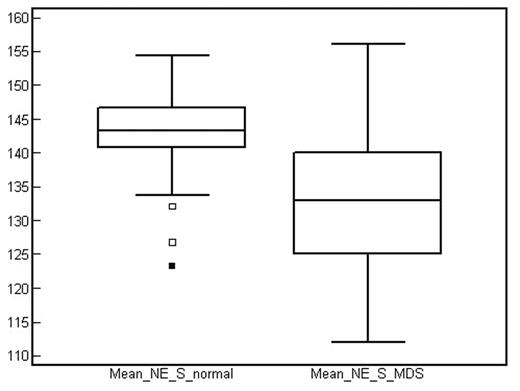Abstract
The assessment of neutrophil dysplasia is very useful for the diagnosis of the Myelodysplastic Syndromes (MDS), and the common accepted method for that purpose is the microscopic examination of blood and/or bone marrow smears. But one of the problems in the daily practice, is the lack of reproducibility between the different observers, and technical problems, like the time of the stain, quality of the stain, including quality of the reagents and time of the smear after blood draw. The last advanced hematology instruments, like the Coulter LH750®, provide, together with the report of the WBC differential, automated morphological data about some of the different types of leukocytes: Neutrophils, Lymphocytes, Monocytes and Eosinophils. This Research Data (RPD), gives information about the Mean and Standard deviation of the Cell Volume, Conductivity, and Scatter using a technology called VCS technology. We have collected 53 patients affected of MDS, and 18 affected with Chronic Myelomonocytic Leukemia (CMML) and we compared the leukocyte automated leukocyte morphological data (WRPD) of the patients with the WRPD of 59 normal persons. One of the modifications in the actual WHO classifications is the differentiation between CMML with or without dysplasia and Mylodysplastic Syndromes with or without trilineage dysplasia, that also affect the prognosis. We have checked also these new parameters for this purpose. The results have shown: The Mean Neutrophil Scatter (MNES) and Mean Neutrophil Conductivity (MNEC) was significant lower in the MDS compared with the normal (both p<0.0001) the ROC curve analysis show a Sensitivity of 71.8% with a Specificity of 86.4% and a cut off of < 139.3 for the MNESand a Sensitivity of 70.4% with a Specificity of 76.3% and a cut off of < 150.9 for the MNECdetecting MDS. For the differentiation of MDS and CMML with or without dysplasia the results have shown a significant difference p = 0.02 in the MNESbetween CMML-1 and CMML-2 and MDS with or without trilineage dysplasia. The changes in the Neutrophil Scatter and in the Neutrophil Conductivity (lower values) correlates with the dysplastic feature neutrophil degranulation observed in the microscope.
Conclussion: MNEC and MNES seem to be useful in the detection of neutrophil dysplasia and helpful in the diagnosis of MDS.
Disclosures: Research population data are for research use only.
Author notes
Corresponding author


This feature is available to Subscribers Only
Sign In or Create an Account Close Modal